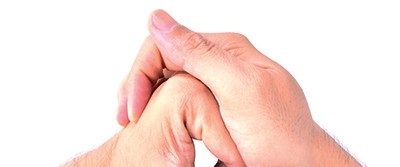The Sonic Mystery of Knuckle Cracking

By Nancy H. Pitts
For more than a century, scientists have been investigating, and debating, why your knuckles make that sound when you crack them. (Or maybe you don’t, but a family member or friend does; some can, while others cannot.) What scientists agree on is that the sound comes from the articular release of the metacarpophalangeal joint, or the snapping of a tendon over the bone in your finger’s joint. But they disagree about why the cracking sound is so loud.
In the 1970s, scientist Anthony Unsworth (University of Durham, U.K.) and his colleagues revealed that the synovial fluid in the joint was involved in the sound. In fact, they attributed the sound to the collapse of bubbles that form in that fluid when the tendon snaps over the joint, like when a balloon pops. This formation of tiny bubbles between two submerged surfaces when those surfaces are suddenly pulled apart is called tribonucleation.
POP!
Three years ago, however, scientist Gregory Kawchuk (University of Alberta) challenged this theory after observing the presence of bubbles after the joint had cracked. Kawchuk didn’t deny that tribonucleation was taking place, but he theorized that it was the sudden growth of the bubble that caused the cracking sound: that’s why the bubbles are still there after the knuckle cracks, he asserted. And virtually all researchers accepted this new bubble theory.
But scientists V. Chandran Suja (Stanford University) and A. I. Barakat still questioned why the cracking sound is so loud that it can be heard from across a room, so they published a mathematical proof in March 2018 that they believe explains it. Although they accept that bubbles in the synovial fluid during the release of the joint account for the noise, they believe it’s the collapse of those bubbles — not their expansion — that creates the sound.
The bubble is actually a void or absence of material. When that void is formed in the knuckle by the pulling apart of the surfaces in the synovial fluid — again, what scientists call tribonucleation — low pressure, known as cavitation, occurs. And when that void starts to collapse, the resulting shock wave caused by the interaction of low pressure with the fluid releases a tremendous amount of energy, which produces the loud cracking sound.
So tribonucleation in the finger joints’ synovial fluid followed by the almost immediate collapse of the subsequent cavitation bubble is what makes the big noise when someone cracks their knuckle. Or, at least, that’s the latest theory.
Discussion Questions
- Can you explain tribonucleation in simple terms?
- Research cavitation videos on YouTube, then try to describe cavitation to someone unfamiliar with the term.
Vocabulary
- Theorize
- Sunovial Fluid
- Metacarpophalangeal Joint
- Cavitation
- Tribonucleation